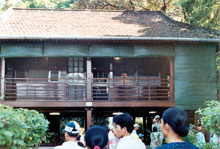People remember Chi Minh as hero

Ho Chi Minh´s home is a short walk from his mausoleum, a Vietnamese tourist attraction.
It is mid-July in Hanoi, which means it is also very hot. I arrived at Ho Chi Minh’s mausoleum at 8:30 a.m. and was ushered into a double line that soon wrapped around the block under a tidy blue canopy erected to provide a hint of relief from the relentless sun. This is not just a tourist attraction for curious foreigners such as myself, although on this morning there are a few Europeans and Australians dotting the lines. From the day the revered revolutionary leader was laid to rest here in 1975, thousands of Vietnamese have traveled from the most remote areas to pay their respects. He died in 1969, but was not given a “final” resting place (his body is flown to Russia once a year for a two month check up) until after the war. It is not as though children are simply force-fed the history of Ho Chi Minh (Vietnamese for “bringer of light”) and the revolution in school. Parents, too, make it a priority not to let the younger generations forget. While this fact is evident throughout Vietnam, the scene here in Hanoi is quite impressive.
The guards open the doors to the mausoleum and the quiet lines begin to move along. Once inside, we are led upstairs and into a large, dimly-lit room. It is here, embalmed in a glass casket, that Ho Chi Minh’s body lies with a spotlight upon it. Armed guards keep the lines moving steadily; you walk as you view. And just like that, the experience comes to an end. The symbolic nature of this site runs deeper, however. This Soviet-built tomb stands where Ho Chi Minh gave his independence speech in 1945, thus opening a new chapter of war against the French that would end in 1975 with the evacuation of American personnel from the roof of the U.S. Embassy in Saigon. It is also just a short walk from the stilted house where “Uncle Ho,” affectionately named because of his love of children, lived and worked from 1958 until his death.
Walking these grounds, I’m told that communism in Vietnam is a “scientific communism,” meaning it is flexible and was designed by Ho Chi Minh specifically for Vietnam and not intended to be exported. Thus the argument is made that someone could lead a communist revolution whose philosophy is rooted in patriotism and nationalism, not despotism. I am also told the story of a would-be assassin, trained in Taiwan, who was coaxed off the roof of this small house, treated as a guest and quickly converted to the revolution. The man later became a member of the government. Visitors here learn about Ho Chi Minh’s love for South Vietnam and his inability to return there during the war. As he lay dying in his house, soldiers from the South carried rocks from the Ho Chi Minh Trail in backpacks all the way to this location in Hanoi so that their beloved leader could walk in the “South” one last time. He was dead by the time they arrived, but the rocks were made into a small path on which his coffin was led from his house.
Regardless of one’s political persuasion, it becomes readily apparent that, unlike his contemporaries in the Soviet Union, Ho Chi Minh practiced the simple life he preached. Perhaps this is why, despite the growing market economy and foreign influence that is a byproduct, Uncle Ho’s popularity does not seem to be on the wane.
Your donation will support the student journalists of Missouri Southern State University. Your contribution will allow us to purchase equipment and cover our annual website hosting costs.



























